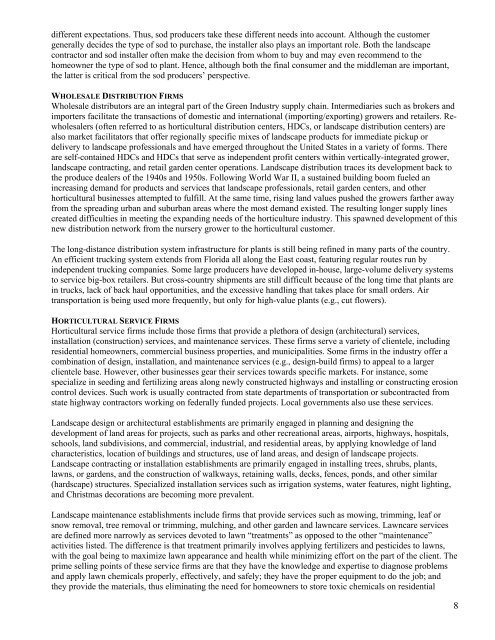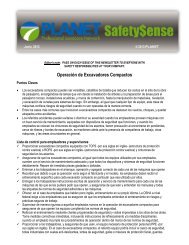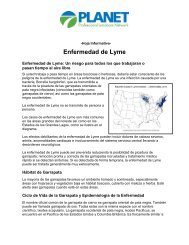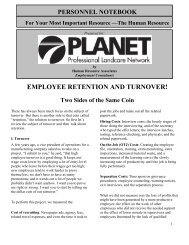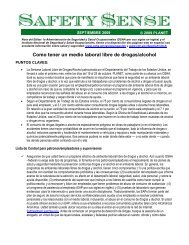Economic Impacts of the Green Industry in the - Urban Forest ...
Economic Impacts of the Green Industry in the - Urban Forest ...
Economic Impacts of the Green Industry in the - Urban Forest ...
Create successful ePaper yourself
Turn your PDF publications into a flip-book with our unique Google optimized e-Paper software.
different expectations. Thus, sod producers take <strong>the</strong>se different needs <strong>in</strong>to account. Although <strong>the</strong> customer<br />
generally decides <strong>the</strong> type <strong>of</strong> sod to purchase, <strong>the</strong> <strong>in</strong>staller also plays an important role. Both <strong>the</strong> landscape<br />
contractor and sod <strong>in</strong>staller <strong>of</strong>ten make <strong>the</strong> decision from whom to buy and may even recommend to <strong>the</strong><br />
homeowner <strong>the</strong> type <strong>of</strong> sod to plant. Hence, although both <strong>the</strong> f<strong>in</strong>al consumer and <strong>the</strong> middleman are important,<br />
<strong>the</strong> latter is critical from <strong>the</strong> sod producers’ perspective.<br />
WHOLESALE DISTRIBUTION FIRMS<br />
Wholesale distributors are an <strong>in</strong>tegral part <strong>of</strong> <strong>the</strong> <strong>Green</strong> <strong>Industry</strong> supply cha<strong>in</strong>. Intermediaries such as brokers and<br />
importers facilitate <strong>the</strong> transactions <strong>of</strong> domestic and <strong>in</strong>ternational (import<strong>in</strong>g/export<strong>in</strong>g) growers and retailers. Rewholesalers<br />
(<strong>of</strong>ten referred to as horticultural distribution centers, HDCs, or landscape distribution centers) are<br />
also market facilitators that <strong>of</strong>fer regionally specific mixes <strong>of</strong> landscape products for immediate pickup or<br />
delivery to landscape pr<strong>of</strong>essionals and have emerged throughout <strong>the</strong> United States <strong>in</strong> a variety <strong>of</strong> forms. There<br />
are self-conta<strong>in</strong>ed HDCs and HDCs that serve as <strong>in</strong>dependent pr<strong>of</strong>it centers with<strong>in</strong> vertically-<strong>in</strong>tegrated grower,<br />
landscape contract<strong>in</strong>g, and retail garden center operations. Landscape distribution traces its development back to<br />
<strong>the</strong> produce dealers <strong>of</strong> <strong>the</strong> 1940s and 1950s. Follow<strong>in</strong>g World War II, a susta<strong>in</strong>ed build<strong>in</strong>g boom fueled an<br />
<strong>in</strong>creas<strong>in</strong>g demand for products and services that landscape pr<strong>of</strong>essionals, retail garden centers, and o<strong>the</strong>r<br />
horticultural bus<strong>in</strong>esses attempted to fulfill. At <strong>the</strong> same time, ris<strong>in</strong>g land values pushed <strong>the</strong> growers far<strong>the</strong>r away<br />
from <strong>the</strong> spread<strong>in</strong>g urban and suburban areas where <strong>the</strong> most demand existed. The result<strong>in</strong>g longer supply l<strong>in</strong>es<br />
created difficulties <strong>in</strong> meet<strong>in</strong>g <strong>the</strong> expand<strong>in</strong>g needs <strong>of</strong> <strong>the</strong> horticulture <strong>in</strong>dustry. This spawned development <strong>of</strong> this<br />
new distribution network from <strong>the</strong> nursery grower to <strong>the</strong> horticultural customer.<br />
The long-distance distribution system <strong>in</strong>frastructure for plants is still be<strong>in</strong>g ref<strong>in</strong>ed <strong>in</strong> many parts <strong>of</strong> <strong>the</strong> country.<br />
An efficient truck<strong>in</strong>g system extends from Florida all along <strong>the</strong> East coast, featur<strong>in</strong>g regular routes run by<br />
<strong>in</strong>dependent truck<strong>in</strong>g companies. Some large producers have developed <strong>in</strong>-house, large-volume delivery systems<br />
to service big-box retailers. But cross-country shipments are still difficult because <strong>of</strong> <strong>the</strong> long time that plants are<br />
<strong>in</strong> trucks, lack <strong>of</strong> back haul opportunities, and <strong>the</strong> excessive handl<strong>in</strong>g that takes place for small orders. Air<br />
transportation is be<strong>in</strong>g used more frequently, but only for high-value plants (e.g., cut flowers).<br />
HORTICULTURAL SERVICE FIRMS<br />
Horticultural service firms <strong>in</strong>clude those firms that provide a plethora <strong>of</strong> design (architectural) services,<br />
<strong>in</strong>stallation (construction) services, and ma<strong>in</strong>tenance services. These firms serve a variety <strong>of</strong> clientele, <strong>in</strong>clud<strong>in</strong>g<br />
residential homeowners, commercial bus<strong>in</strong>ess properties, and municipalities. Some firms <strong>in</strong> <strong>the</strong> <strong>in</strong>dustry <strong>of</strong>fer a<br />
comb<strong>in</strong>ation <strong>of</strong> design, <strong>in</strong>stallation, and ma<strong>in</strong>tenance services (e.g., design-build firms) to appeal to a larger<br />
clientele base. However, o<strong>the</strong>r bus<strong>in</strong>esses gear <strong>the</strong>ir services towards specific markets. For <strong>in</strong>stance, some<br />
specialize <strong>in</strong> seed<strong>in</strong>g and fertiliz<strong>in</strong>g areas along newly constructed highways and <strong>in</strong>stall<strong>in</strong>g or construct<strong>in</strong>g erosion<br />
control devices. Such work is usually contracted from state departments <strong>of</strong> transportation or subcontracted from<br />
state highway contractors work<strong>in</strong>g on federally funded projects. Local governments also use <strong>the</strong>se services.<br />
Landscape design or architectural establishments are primarily engaged <strong>in</strong> plann<strong>in</strong>g and design<strong>in</strong>g <strong>the</strong><br />
development <strong>of</strong> land areas for projects, such as parks and o<strong>the</strong>r recreational areas, airports, highways, hospitals,<br />
schools, land subdivisions, and commercial, <strong>in</strong>dustrial, and residential areas, by apply<strong>in</strong>g knowledge <strong>of</strong> land<br />
characteristics, location <strong>of</strong> build<strong>in</strong>gs and structures, use <strong>of</strong> land areas, and design <strong>of</strong> landscape projects.<br />
Landscape contract<strong>in</strong>g or <strong>in</strong>stallation establishments are primarily engaged <strong>in</strong> <strong>in</strong>stall<strong>in</strong>g trees, shrubs, plants,<br />
lawns, or gardens, and <strong>the</strong> construction <strong>of</strong> walkways, reta<strong>in</strong><strong>in</strong>g walls, decks, fences, ponds, and o<strong>the</strong>r similar<br />
(hardscape) structures. Specialized <strong>in</strong>stallation services such as irrigation systems, water features, night light<strong>in</strong>g,<br />
and Christmas decorations are becom<strong>in</strong>g more prevalent.<br />
Landscape ma<strong>in</strong>tenance establishments <strong>in</strong>clude firms that provide services such as mow<strong>in</strong>g, trimm<strong>in</strong>g, leaf or<br />
snow removal, tree removal or trimm<strong>in</strong>g, mulch<strong>in</strong>g, and o<strong>the</strong>r garden and lawncare services. Lawncare services<br />
are def<strong>in</strong>ed more narrowly as services devoted to lawn “treatments” as opposed to <strong>the</strong> o<strong>the</strong>r “ma<strong>in</strong>tenance”<br />
activities listed. The difference is that treatment primarily <strong>in</strong>volves apply<strong>in</strong>g fertilizers and pesticides to lawns,<br />
with <strong>the</strong> goal be<strong>in</strong>g to maximize lawn appearance and health while m<strong>in</strong>imiz<strong>in</strong>g effort on <strong>the</strong> part <strong>of</strong> <strong>the</strong> client. The<br />
prime sell<strong>in</strong>g po<strong>in</strong>ts <strong>of</strong> <strong>the</strong>se service firms are that <strong>the</strong>y have <strong>the</strong> knowledge and expertise to diagnose problems<br />
and apply lawn chemicals properly, effectively, and safely; <strong>the</strong>y have <strong>the</strong> proper equipment to do <strong>the</strong> job; and<br />
<strong>the</strong>y provide <strong>the</strong> materials, thus elim<strong>in</strong>at<strong>in</strong>g <strong>the</strong> need for homeowners to store toxic chemicals on residential<br />
8


